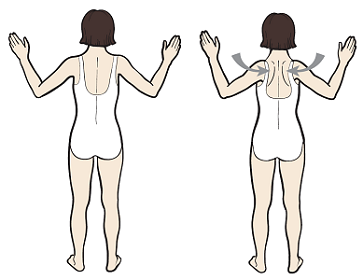EXERCISES + LIMITATIONS
For most surgeries involving the breast and body, the incisions will take about 6-8 weeks to gain full strength. You should avoid strenuous activity during this time period in order for the incisions to heal properly. It will take many more months for the scars to remodel, but by 8 weeks, the majority of the strength to the incisions will have returned. In general, we recommend avoiding lifting anything greater than 5lbs for the first 4 weeks, and gradually increase this to 10-20lbs by 6-8 weeks depending on the type of surgery you have had.
BREAST REDUCTIONS and ONCOPLASTIC REDUCTIONS are rather straightforward as they don't involve any underlying muscle. I would recommend using caution in raising your arms greater than 90 degrees (shoulder level) for the first few weeks, and then stretching slowly after that as your incisions gain more strength.
BREAST AUGMENTATION can involve the pectoralis at times and may require for you to limit your lifting for longer. If your implant was placed above the muscle in the "subfacial" or "subglandular" plane, you will be able to return to most activities in 4 weeks as long as you are wearing good support. The implant will settle in place nicely as long as the capsule that forms around the implant does not stretch out with too much activity . If your implant was placed under the pectoralis muscle, or in the "subpectoral" space, you will want to minimize activities that activate your pectoralis muscle, such as lifting, pulling up, etc. Using your pectoralis early can push down on your implant and stretch out your capsule, which will cause the implant to push out. You may lose some inner cleavage due to this.
MASTECTOMY RECONSTRUCTION
Mastectomy reconstruction recovery is more involved than the above surgeries. Because there is more raw surface area that needs to heal (and thus more fluid and drain managemen ), we limit our upper body activity for the first several weeks. I like the post-mastectomy exercises that are on the Memorial Sloan Kettering website here. In case the link gets changed, I have borrowed their instructions.
WEEKS 0-2:
I am ok with raising your elbows to shoulder-level (90 degrees) but prefer not anything above that. So no reaching on high shelves or microwaves. The more you move your arms, the more things rub inside. This creates more fluid, and your drains will stay in longer!
DEEP BREATHING EXERCISE
Deep breathing can be relaxing but also essential in keeping your lungs healthy. You will be given an incentive spirometer while in the hospital. Take slow deep breaths in through the spirometer (try to get above 1500ml), 10 breaths an hour while you're awake. If you do not have the spirometer, sit comfortably in a chair and take slow deep breaths through your nose. Focus on allowing your chest and belly to expand. Breathe slowly out through your mouth.
SHOULDER ROLLS
These will be a gentle way to stretch your chest and shoulder muscles without dramatically moving your reconstruction. Sit comfortably with your arms at your sides. [Backward shoulder rolls] Using a circular motion, move your shoulders forward, up, backward, and down. Do this 10 times. Switch directions and do the rolls forwards 10 times.

WEEKS 2-4:
SHOULDER WINGS
This exercise will help you get back outward movement of your shoulder. You can do it while sitting or standing. Place your hands on your chest or collarbone. Raise your elbows out to the side. Raise them as high as you can, up to shoulder level . Slowly lower your elbows. Do this 10 times. Then, slowly lower your hands. If you feel discomfort while doing this exercise, hold your position and do the deep breathing exercise. If the discomfort passes, raise your elbows a little higher. If it doesn’t pass, don’t raise your elbows any higher. Finish the exercise raising your elbows only high enough to feel a gentle stretch and no discomfort.

SIDE WALL CLIMBS
Position your body with your side facing the wall. This should not be painful but it is normal to feel some tightness. Slowly crawl your fingers up the wall as far as you can. When you get to the point where you feel a good stretch (but not pain!), do the deep breathing exercise. Slowly return by crawling your fingers down the wall.

FRONT WALL CLIMBS
Position your body facing the wall. Slowly crawl your fingers using both hands up the wall as far as you can. When you get to the point where you feel a good stretch (but not pain!), do the dep breathing exercise. Slowly return by crawling your fingers down the wall.

WEEKS 4-6:
I usually send patients to physical therapy at this point. They can work on range of motion, strength training, lymphatic massage and a number of things to help restore you to maximal comfort and function. The physical therapist will provide a home exercise program. Until you meet with them, you can work on some of these exercises below.



